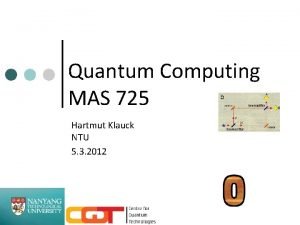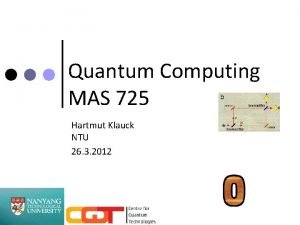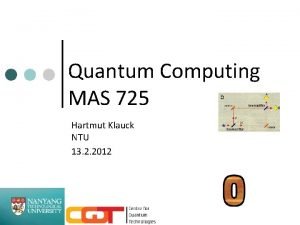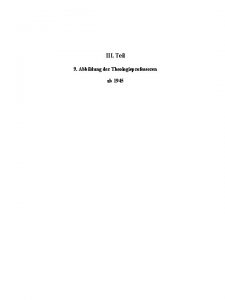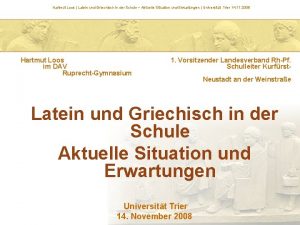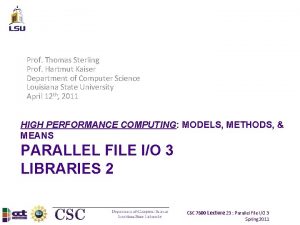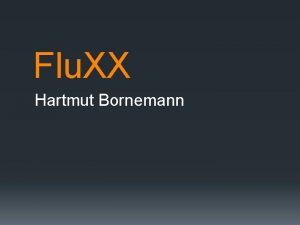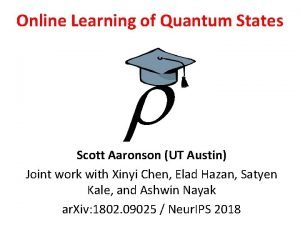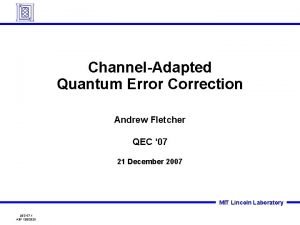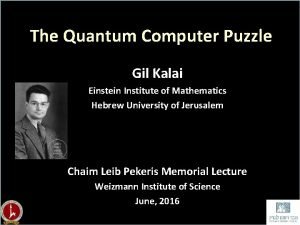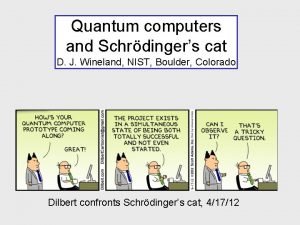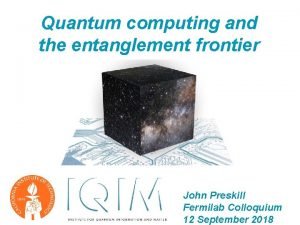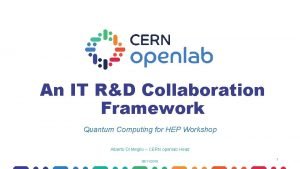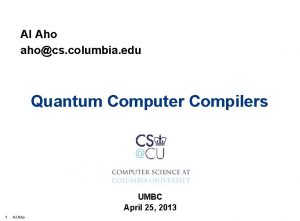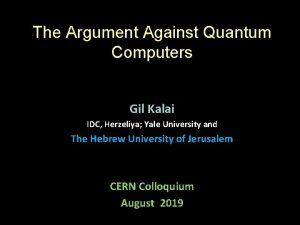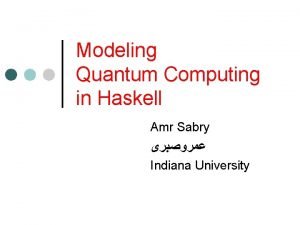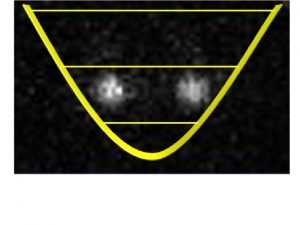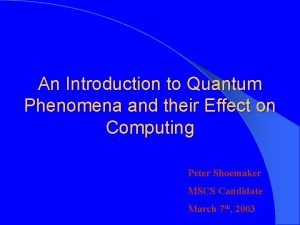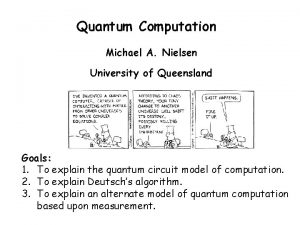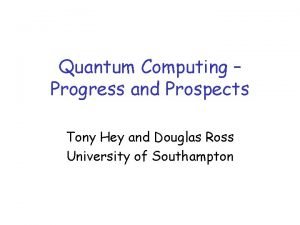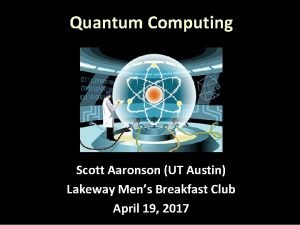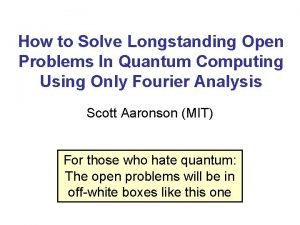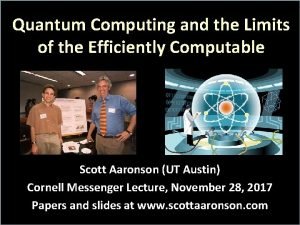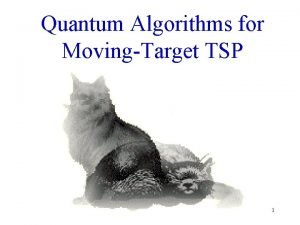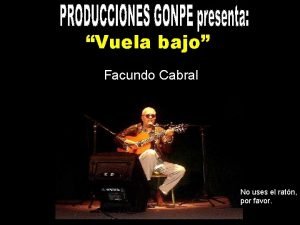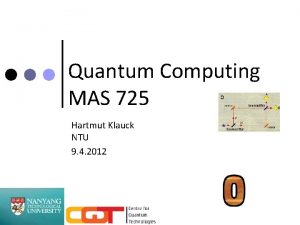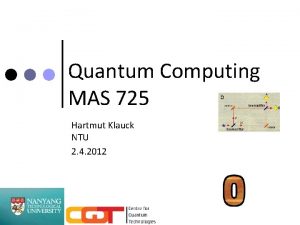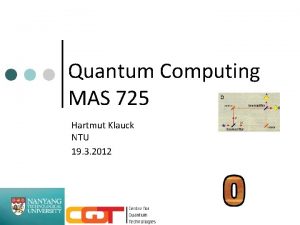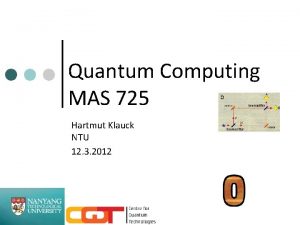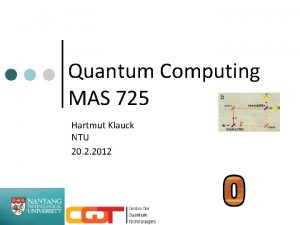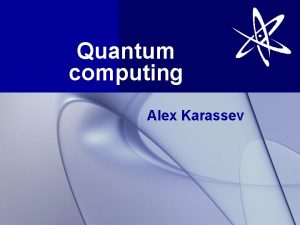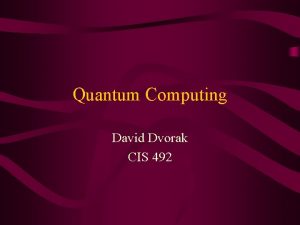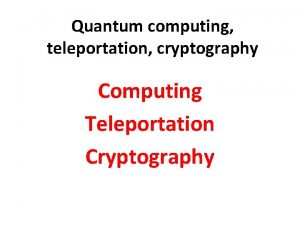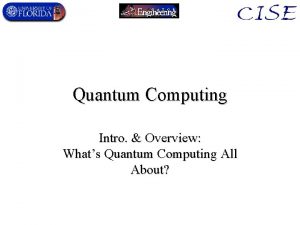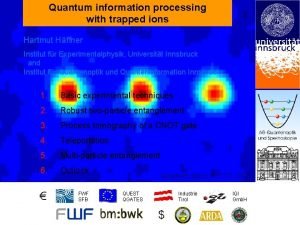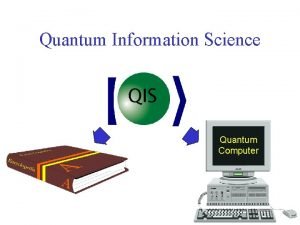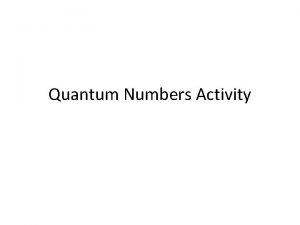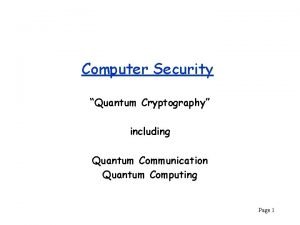Quantum Computing MAS 725 Hartmut Klauck NTU 5




















![Quantum Teleportation ¢ ¢ ¢ ¢ [Bennett et al. 93] Alice and Bob share Quantum Teleportation ¢ ¢ ¢ ¢ [Bennett et al. 93] Alice and Bob share](https://slidetodoc.com/presentation_image_h/07e29b8b64292f8238ba2f715c595989/image-21.jpg)








- Slides: 29

Quantum Computing MAS 725 Hartmut Klauck NTU 5. 3. 2012

More about measurements(I) Some linear algebra: ¢ Vector space V (dimension d) ¢ Subspaces: U µ V and U is also a vector space (dim e < d) ¢ There is an orthonormal basis: v 1, . . . , ve, . . . , vd, span(v 1, . . . , ve)=U ¢ Projection onto U: ¢ PU = i=1. . . e | v iih vi | ¢ Example: Projector P=|v 1 ih v 1| P |v 1 i = |v 1 ih v 1| v 1 i = |v 1 i P ( |v 1 i+ |v 2 i)= |v 1 i + |v 1 ih v 1| v 2 i = |v 1 i ¢

Measurements (II) ¢ ¢ A? B iff v? w for all v 2 A, w 2 B A © B=V iff A? B and for all v 2 V: v = u + w, u 2 A, w 2 B, kuk, kvk = 1, | |2 + | |2=kvk 2

Measurements (III) ¢ ¢ ¢ ¢ Hilbert spaces V, dim k Observable: System l · k of subspaces S 0, . . . , Sl-1, pairwise orthogonal S 0© ©Sl-1 = V Probability of measuring i is k Proj(Si) | i k 2 The state | i collapses to Proj(Si) | i / k. Proj(Si) | ik (renormalized) Observables correspond to a measurement device We only consider projections measurements

Measurements (IV) ¢ ¢ A matrix A is Hermitian, if A=Ay Hermitian matrices have only real eigenvalues and are diagonalizable: l Uy A U is diagonal for some unitary U The eigenspaces of A decompose Cn l Cn=©Vi Let ¸(i) denote an eigenvalue of A, and Pi the projection onto its eigenspace l Then A= i ¸(i) Pi

Measurements (V) ¢ A Hermitian matrix is a concise representation of an observable l Eigenvalues correspond to measurement outcomes l Eigenspaces decompose Cn

Measurements: example ¢ ¢ ¢ Two qubits, living in C 4 Observable: S 0=span(|00 i, |01 i) S 1=span(|10 i, |11 i) S 0 ? S 1 This observable corresponds to measuring the first qubit: S 0 indicates that it is 0, S 1 indicates 1

Measuring an EPR-Pair ¢ ¢ ¢ The state is 1/21/2 ¢ (|00 i+|11 i) We measure the first qubit Result: If we measure 0, then the state collapses to |00 i If we measure 1 we get |11 i Each happens with probability ½ Qubit 2 collapses right after measuring qubit 1 The qubits act like a shared public coin toss. This is even true if the qubits are spatially separated

Summary ¢ ¢ ¢ ¢ Hilbert space: register holding a quantum state Vectors: states Unitary transformation: evolution of states (computation) Observables: for measuring the computation‘s output The probability distribution on results: output of the computation Projected and normalized vector: the remaining quantum state Measurement is the only way to extract information from a quantum state

More about qubits ¢ ¢ ¢ No-Cloning Theorem Bell states Quantum Teleportation

No Cloning ¢ ¢ ¢ Suppose we are given a quantum state | i Can we make a copy? Copying classical information is trivial (ask the music industry about that…) I. e. , there is a unitary transformation Un: Un|xi|0 i = |xi|xi for all x 2{0, 1}n But then by linearity U 1 1/2. 5(|0 i+|1 i) |0 i= 1/21/2 (|00 i+|11 i) 1/21/2(|0 i+|1 i) times 1/2. 5(|0 i+|1 i)

No Cloning Theorem ¢ Theorem: There is no unitary U, such that for all quantum states | i on n qubits: U | i |0 mi = | i | ( )i ¢ for some m und | ( )i (which is garbage) I. e. there is no universal way to copy unknown quantum states without error! ¢ [Dieks, Wootters/Zurek 82]

Proof: No Cloning ¢ ¢ ¢ Let a linear U be given (this also fixes m). Then U |0 ni |0 mi =|0 ni | 0 i U |1 ni |0 mi =|1 ni | 1 i ¢ Then also (due to linearity) U 1/21/2 ( |0 ni+|1 ni ) |0 mi = 1/21/2 ( U |0 ni|0 mi + U |1 ni|0 mi ) = 1/21/2 ( |02 ni | 0 i + |12 ni | 1 i ) ¢ But we wanted (for some | 2 i) 1/2 (|0 ni+|1 ni) | 2 i

Proof: No Cloning (II) ¢ We have 1/21/2 ( |02 ni | 0 i + |12 ni | 1 i ) We want 1/2 (|0 ni+|1 ni) | 2 i ¢ Claim: This is not the same! ¢ Proof of the claim: we compute the inner product. Same state ) inner product = 1 h | i = h | i ¢ h | i h + | i=h | i + h | i ¢ ¢ ¢

Proof No Cloning (III) ¢ ¢ We get 1/21/2 ( |02 ni | 0 i + |12 ni | 1 i ) We expect 1/2 (|0 ni+|1 ni) | 2 i Inner product: 1/23/2 ¢ ( ( h 0 n|0 ni+h 0 n|1 ni ) ¢ h 0| 2 i ) +( h 1 n|0 ni+h 1 n|1 ni) ¢ h 1| 2 i ) ) = 1/23/2 ¢ (1 ¢ a 0, 2 + 1 ¢ a 1, 2). Then |1/23/2 ¢ ( a 0, 2+a 1, 2)| · 2/23/2 < 1

No Cloning ¢ ¢ No unitary can map both a state and another state that are not orthogonal in a way that wakes a copy It is possible to clone quantum states with small success probability

Bell States ¢ Consider the following basis (John Bell) ¢ This is orthonormal in C 4

Generating Bell states x H | x, yi y CNOT Gate: CNOT |0, yi =|0, yi; CNOT |1, yi=|1, 1 -yi | 0, 0 i = 1/21/2 (|00 i +|11 i)=| +i

Quantum Teleportation ¢ ¢ ¢ We are given a quantum state | i Can we reproduce that state in another location? We cannot just send them over…. And we cannot copy them Classical communication is possible This problem seems hard since a single qubit 0 |0 i+ 1 |1 i might contain a lot of information due to possibly irrational amplitudes

Quantum Teleportation | i Local operations Classical Communication Local operations 1/21/2 (|00 i+|11 i)
![Quantum Teleportation Bennett et al 93 Alice and Bob share Quantum Teleportation ¢ ¢ ¢ ¢ [Bennett et al. 93] Alice and Bob share](https://slidetodoc.com/presentation_image_h/07e29b8b64292f8238ba2f715c595989/image-21.jpg)
Quantum Teleportation ¢ ¢ ¢ ¢ [Bennett et al. 93] Alice and Bob share an EPR pair (Alice has the first qubit, Bob the other) Alice has | i (1 qubit quantum state) Alice applies CNOT to her qubit q 0 with | i (control) and her EPR qubit q 1 Alice applies H to q 0 and measures q 0 and q 1 Alice sends the result of the measurement (2 bits) Bob applies a unitary transformation depending on the message to his EPR qubit q 2

Quantum Teleportation q 1, q 2: EPR Pair; q 0: | i; q 0, q 1 with Alice, q 2 with Bob Measurement

Pauli Transformations ¢ X: (NOT, Bit Flip) ¢ Z: (Phase Flip) ¢ Y:

Quantum Teleportation Create EPR Pair

Quantum Teleportation ¢ ¢ ¢ ¢ Then: CNOT on q 0 and q 1 x=0, 1 x |xi y=0, 1 1/21/2|y, yi CNOT: x, y x/21/2 |x, x © y, yi Measure q 1: Result is a Prob. for 0/1 is 0. 5 each: | 0|2/2+| 1|2/2=1/2 Remaining state: y y©a |y © a , yi on q 0, q 2 Send a to Bob a=0 ) Bob does nothing a=1 ) Bob applies X-Gate (Bit Flip) Result in both cases: y y©a|y © a, y © ai = y y |y, yi

Quantum Teleportation ¢ ¢ State y y |y, yi Problem: Bob’s qubit q 2 is still entangled with q 0 y y |y, yi

Quantum Teleportation ¢ ¢ ¢ Alice applies H to q 0 Alice measures q 0, assume the result is b, she sends b to Bob Applying H: y y |y, yi 1/21/2 z, y y (-1)z¢ y |z, yi ¢ Measuring q 0 (Result is b; 0/1 with Prob. 1/2): y y (-1)b¢ y |yi on q 2 ¢ Bob corrects by applying a Z-Gate, if necessary

Quantum Teleportation y y|yi

Remarks ¢ ¢ ¢ The EPR-pair is consumed The original state | i is destroyed [no cloning!] States with many qubits can be teleported one by one (we need to make sure entanglement between the teleported qubits is preserved)
 Bell states
Bell states Hartmut klauck
Hartmut klauck Hartmut klauck
Hartmut klauck Hans-josef klauck
Hans-josef klauck 1,151,725 bytes
1,151,725 bytes 869 en yakın yüzlüğe yuvarlama
869 en yakın yüzlüğe yuvarlama Classical physics
Classical physics Quantum physics vs mechanics
Quantum physics vs mechanics Loos loos situation
Loos loos situation Hartmut kaiser
Hartmut kaiser Hartmut bornemann
Hartmut bornemann Hartmut vöhringer
Hartmut vöhringer Online learning of quantum states
Online learning of quantum states Mit quantum computing
Mit quantum computing Gil kalai quantum computing
Gil kalai quantum computing Dilbert quantum computing
Dilbert quantum computing Quantum computing and the entanglement frontier
Quantum computing and the entanglement frontier Cern openlab quantum computing
Cern openlab quantum computing Mit quantum computing
Mit quantum computing Gil kalai quantum computing
Gil kalai quantum computing Amr sabry
Amr sabry Prerequisites for quantum computing
Prerequisites for quantum computing Quantum computing meaning
Quantum computing meaning Michael nielsen quantum
Michael nielsen quantum Quantum computing: progress and prospects
Quantum computing: progress and prospects Quantum computing ut austin
Quantum computing ut austin Open problems in quantum computing
Open problems in quantum computing Quantum computing
Quantum computing Tsp quantum computing
Tsp quantum computing Vuela bajo facundo cabral
Vuela bajo facundo cabral
